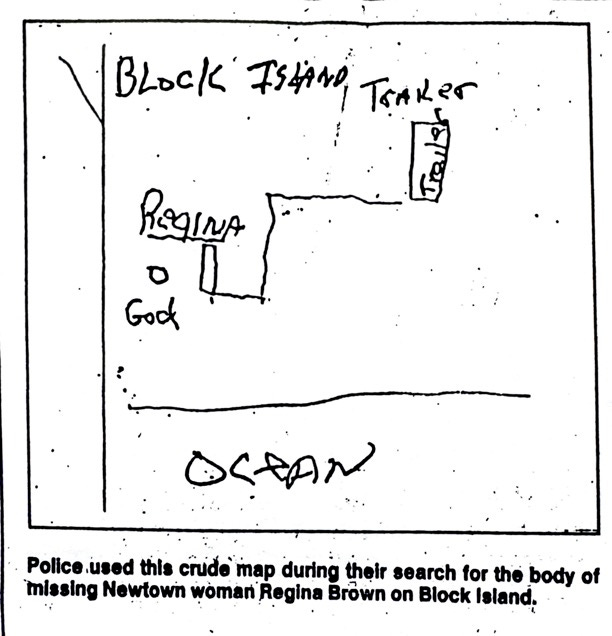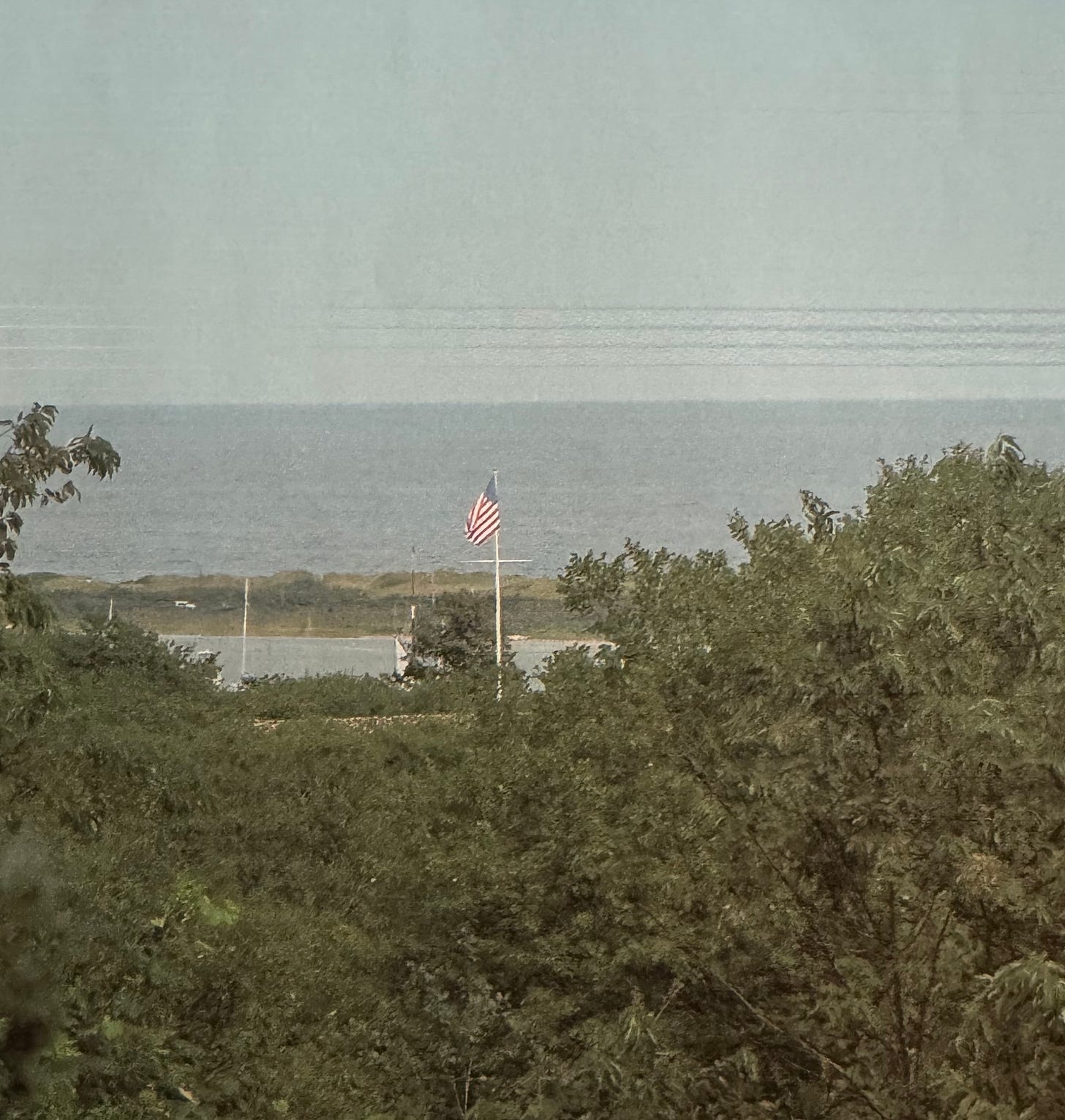A Block Island Visit Unearths Rumors
The Woodchipper Murder takes all the air out of the room
After my failed interview with murder suspect Willis Brown in 2006, Bobby T, the retired Newtown Detective Sgt. and I drove around Block Island to the area police searched in 1989 after a map surfaced that might indicate where Regina Brown’s body was buried. The map depicted a trailer, the ocean, a square and some lines. The word’s “Regina O God” were scrawled across the center.
We found the site behind a new housing development. The land was subdivided and recently built homes pressed up against a never lived-in, weather-beaten gray contemporary halfway up Beacon Hill. Its sharp outline blended into the billowy dark clouds.
As we walked up the crushed shell driveway, our loud footsteps scattered the wild birds nesting in the bushes. We stopped dead in our tracks when we saw a twisted, mangled house trailer crumpled like a discarded soda can in the overgrown yard. It rested on its side with its front door hanging ajar, side split open, and metal roof buckled.
“Is that the same trailer Willis lived in during 1987 after Regina disappeared?” I asked.
“No, it doesn’t look anything like it,” he said.
Bobby T walked around the rugged property, looking down over a lush valley of scrub bushes, small saplings, and native evergreen brush which thrive in the harsh island winters. But it was summer then. From our vantage point on top of Beacon Hill, we had a seagull’s eye view of where police dug some holes looking for Regina Brown’s remains while searching the low-lying area in 1987.
As he raised his head, Bobby T’s gaze caught something. I looked, too. Across the island against a blue ocean framed by green brambles rose a tall white flagpole. Its bright red, white and blue flag rippled in the nautical wind. It reminded me, and perhaps Bobby T, of Newtown’s own tall white flagpole in the middle of historic Main Street. I took a photo of it.
This summer scene reminded me of an iconic winter scene, when a photographer from the News-Times stood atop Castle Hill Road in Newtown on the morning of November 19, 1986, and captured the town’s flagpole in the aftermath of Storm Carl. As days turned to weeks after that late autumn storm, the iconic photo came to symbolize the morning after the woodchipper murder.
That morning was also when Willis violated the restraining order for the first time keeping him away from Regina, their three children, and his house. Regina asked him to help her get the coal stove heat working after the electricity had gone out.
We stood at the highest elevation on Block Island on that summer day in 2006. I watched Bobby T. I imagined he was also recalling the woodchipper murder. Remembering how the Newtown detectives were questioned about their handling of the woodchipper investigation.
How the state’s attorney at the time, Walter Flanagan, removed Newtown police from the woodchipper case. The same state’s attorney, who just four months later when Regina Brown disappeared wouldn’t apply for a search warrant for her house when asked by the local cops to aid in their investigation.
Finally, Bobby T raised his arm slowly and pointed to where, decades before, several searches for Regina’s remains turned up nothing.
“Over there. We brought a search dog, too,” he said
As we walked closer, Bobby T told me the road was different now than during the search. Just then, a man appeared on the road. He was a year-round resident who lived in the new home right next to the overgrown field where a cadaver dog once searched for “...body parts, or body in whole, skeleton remains, blood, saliva, hair...” or, according to the 1989 search warrant, “the remains of Regina Brown.”
It’s always the Woodchipper murder
The man owned the propane company on the island, and Willis was one of his customers. He told us he was nineteen when Regina disappeared and showed us where the trailer that Willis, his father, and step-mother lived in during the summer of 1987 used to be. I asked him what he has heard over the years about Willis’s missing wife.
He started by recounting another murder, how a pilot put his wife’s frozen body into a woodchipper.
“That’s Richard Crafts you’re taking about,” I reminded him. He said he got confused because the pilots worked for the same airlines (which they didn’t). He also heard that Willis owned a small airplane at the time—a “Beechcraft single engine.”
“First, I heard he chipped her up, too. Then I heard he chucked her out the plane in pieces, and finally, years later, I heard they found her alive living down south in Alabama or somewhere,” he said. After some more small talk, I thanked him for his time, wrote his name and phone number in my little notebook, and headed back to the car with Bobby T.
Later in the afternoon, we met a meter reader on Beacon Hill Road. I asked him what he heard on the island.
“I remember that story… Regina Brown, I heard she was found living in Australia, no, no Africa. They cleared Willis of all the charges,” he said. I raised my eyebrows and shot a glance at Bobby T. He just shook his head. The meter reader told us we were “crazy” to believe she was dead.
“You don’t believe me, go talk to the police, or Willis. Willis will tell you,” he told us.
The Block Island Times morgue
After hearing the island folklore, I wanted to stop at the weekly Block Island Times newspaper to do some research. The editor was out of the office, and the only person in the building was the man who ran the newspaper clipping morgue, a place they store old hard copy articles by topic. He told me he had never heard of Regina Brown. As I scrolled through the microfilm to September 1989, I found just a handful of articles detailing the search for her body. What I saw for the first time was a large copy of the map on the front page. I paid for copies, bundled up my papers, and decided that’s enough research for one day.
We dropped off the rental car and, before we left, did some souvenir shopping on Water Street. Block Island booty in tow, we headed back to the ferry dock for our trip home. Waiting for the ferry, we ended up back where the day began, at the picnic tables with green umbrellas next to The Moped Man rental shack. I sat next to Bobby T and watched him watch Willis, who was back at his moped stand chatting with two pretty, young, white women.
“I want to go punch him out,” Bobby T said.
“That’s a bad idea,” I counseled.
A few minutes later we boarded the ferry. As it pulled away from the dock, the sun edged toward dusk, the late afternoon clouds cleared, and the mist evaporated. A faint rainbow formed a classic arch over the island. Bobby T leaned on the ferry railing near an American flag flying on the stern. I took a picture of him with Old Glory before I turned to say goodbye to Block Island.
“Look! The rainbow is pointing to its pot of gold,” I said. Bobby T follows my finger as I pointed to the former search area where police once hoped to find the remains of Regina Brown. We stood there together on the back of the ferry, looking out over his past and my future.





